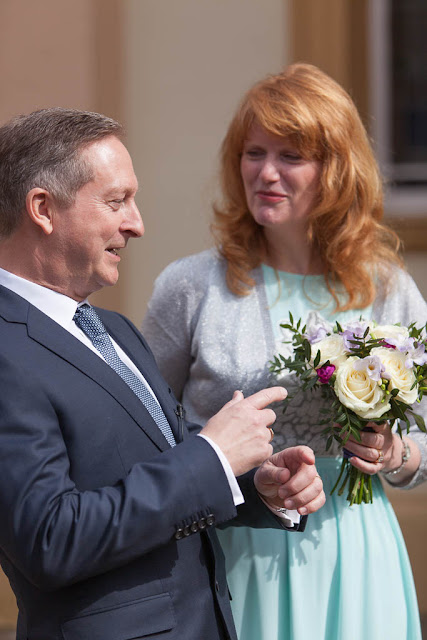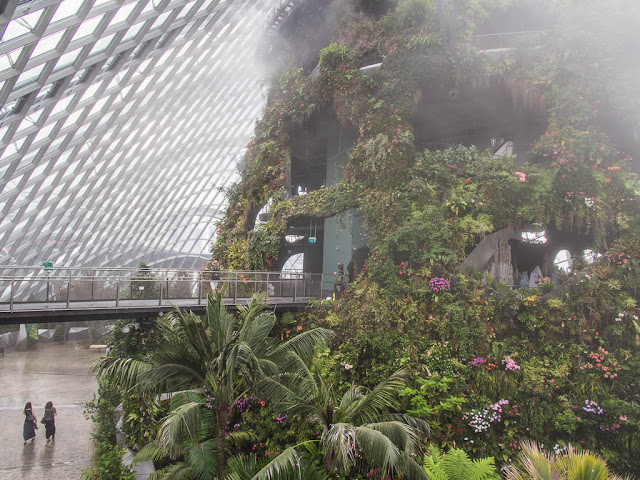There have been a few discussions recently, on the Flickr forum and on the OCA blog, about the merits of students acting as wedding photographers. As I was "booked" to photograph a wedding recently these were very timely and deserving of comment here in my blog.
I have now acted as the primary wedding photographer in 6 weddings, including the most recent one. I don't do more than 1 or 2 in any year and only ever photograph people I know. I don't make any money out of this, in fact it is usually quite expensive for me, taking into account travel, equipment, printing, and my time after the event to process the images. I have never charged, partly because I don't need to, but also because it would create tax issues that I do not need for what is a relatively small amount (compared to my annual income). I view weddings as an opportunity to practice professional skills with a large group of free models. A nice bottle of wine or evening out is the usual compensation, however, seeing the look on the brides face when she gets the final results is payment enough. It might sound foolishly romantic, but I really enjoy being able to help my friends and give them something that they will cherish in the years to come - hopefully!
There is an ethical dimension to this, I have a good job and no need to make money from photography, many pro's do not and so every time I shoot a wedding for free I am diverting money away from the industry. For this I have no answer, my subjects are almost all highly paid professionals well able to afford a photographer, they simply like me to do the photographs because I am a friend and they trust me to do a good job. I guess what they save on me goes towards a better honeymoon. On my side, I am using these opportunities to build a portfolio of wedding albums that I may, one day, have to lean on for an income, so although I currently do not charge, this is an investment in future earnings. Hopefully I will never need this, but you never know these days.
The downside is that I am finding that I no longer really enjoy shooting weddings, it is extremely hard work, a long day running from place to place with a heavy camera bag. It is also very stressful, making sure that every key moment is recorded and that at all times my camera is setup correctly, ISO, F-stop, shutter speed, right lens, I never stop computing the requirements of any given shot. Weddings never have good light, the church is dark, the sunlight outside that everyone smiles about is way too bright, the dinner has yellow lighting, the first dance, well you get the message. A typical wedding is 10-12 hours camera in hand, 1,000 or more photographs. I look at the guests as they eat and drink, enjoying a fun day - I know what happens after a drink or two, DSLRs are unforgiving of insobriety. I wish I was them, just having a good time.
Then comes the afterwork, hundreds of photos to sort through, edit for contrast and colour, then to sequence into a narrative that tells the story of the day. This is unforgiving work, grinding through photographs trying to make sense of an event and build a story. I don't know the relationships, I might be missing a key person, all I can do is select on the basis of photographic quality and whether the image captures the spirit of the day, then vary it a bit. Stress, stress, stress...
However, there are upsides. The aspect of wedding photography that I truly enjoy is that Heidi and I (Heidi acts as second shooter) become a part of their extended family for the day getting to know a group of people we would not have a chance otherwise. We are also an integral part of their day, especially Heidi, who always has an emergency kit in her camera bag, safety pins, makeup, plasters, stuff the modern bridesmaid does not seem to realize is a part of their responsibility. It is always strange at the end to walk away knowing that I will never meet these people again.
All said and done, though, I have gained a huge amount from my occasional foray into the world of wedding photography. I know what it is to get it right in the camera, there is no second chance, you cannot return to a location to improve a poor shot. I have built a good toolbox of techniques in shooting, but also in post production and book design. I also have an insight into the professional world, and understand the economics of the business better.
I have no illusions about how hard it must be to make a living as a wedding photographer. The wedding itself, depending on the requirements, might be two people working 8-12 hours plus travel to and from the venue. Add to that the preparation, meetings to understand the couples needs, assembling equipment, and recon of location to understand the light and opportunities for shots. Then factor in the processing of the images and assembly into an album. I would put this at a good five 8-hour days per wedding. Then there is the marketing and general administration of a small business. Equipment is also not cheap. Creating a business out of this and one that would generate a reasonable income is no easy task.
Back to my most recent "gig". Kathryn is one of our oldest friends, we have known her in Munich for 15 years or more. She and her long time fiance, Brian, finally tied the know in Singapore prior to moving to South Korea. This was a small event, and we were not able to make it. However, they still wanted a proper church service and so a blessing was arranged for the 6th April in Coleraine on the northern coast of Ireland. To all intensive purposes this was a wedding, all that changed were the words.
It was a new experience, a Northern Ireland Presbyterian church. I was very restricted in what I could do in the church itself, during the service I shot from the balcony, to avoid distraction. But overall the day followed the traditional pattern, of service, sit down reception and dancing. We managed to extract the couple to a local park for a portrait session, but otherwise we were a part of the wedding, guests with cameras - simply much bigger cameras than everyone else. We did establish ourselves as the wedding photographers, so people did give us priority and space.
Mixed feelings, in a way I would have liked to have been a guest and simply enjoyed the day, but I know damn well that I would have been itching to take photographs...
I worked the material into a Blurb book and present below some of my favorite shots from the day.

























